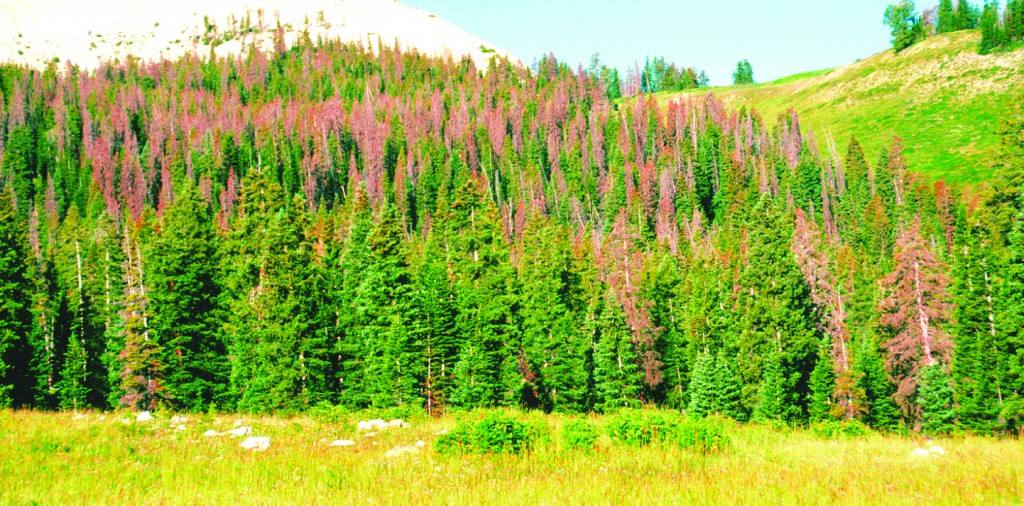Forest Health 2019: Viewpoint on the insects

Land, Water & People
SAN LUIS VALLEY - The 2019 forest health survey results were released last week and, once again, indicated a decline in activity of two forest insects that have most noticeably impacted the Rio Grande National Forest for several years: The Spruce beetle and Douglas-fir beetle.
The Douglas-fir beetle spread was nearly negligible for 2019, affecting only 670 acres with scattered pockets of mortality. The spruce beetle infestation spread another 6,700 acres in 2019, down significantly from the 34,000 acres in 2018 and 47,000 acres in 2017. In total, the spruce beetle has infested about 622,000 acres of spruce-fir and mixed conifer forest on the Rio Grande National Forest. That is one-third of the Forest.
The decline in spruce beetle impact is a result of the beetles running out of food. The primary food source for the spruce beetles in this area is our mature, high-elevation Engelmann spruce and, frankly, there aren’t many uninfested stands left. The beetles are able to infest blue spruce in certain instances, but mostly they prefer Engelmann spruce.
We did experience a 7,000 acre increase in Western spruce budworm activity, up to 27,000 acres affected. Activity was most evident in the northern part of the Saguache district and the southern part of the Conejos Peak district. Spruce budworms eat the new needles on coniferous trees such as Douglas fir, white fir, subalpine fir and spruce. They typically don’t kill trees unless they stay active in an area for several years. This may be the case in some areas of the forest.
These issues have been considered from many angles and one aspect remains the same: there was nothing the Rio Grande National Forest could do to stop these natural disturbances. However, in response, the Forest has conducted numerous timber sales to salvage dead and dying trees for commercial sawtimber. But even that cycle may be declining due to the diminishing value of the salvageable timber. We will continue to offer new salvage sales as long as the dead timber still has value, the areas we can work in are suitable, and we receive funding to develop the projects. We will also continue to design projects that reduce stand densities and fuel loading in order to manage for a resilient landscape.
It is important to remember that all three of these insect species are native to Colorado. Often, they will have temporary, localized impacts to the forest. While other times, such as the spruce beetle epidemic, their affect will be noticeable for much of our lifetime. That may be hard for many of us to accept, but we must also remember that the forests around us have been changing throughout the millennia. They need change to survive the long-term. Insects and wildfires are the two agents of change we are most familiar with. It is the swift and stark changes from these events that we humans must often place a label on. I’ll submit to you that we are the only species to view these changes as bad. This suggests that all the affected plant, animal, insect and bird species simply recognize the change and either adapt, move away or perish. That is nature.
There is also much talk about the wildfire potential as a result of the dead trees. While dead trees with needles can certainly support extreme fire behavior under the right conditions, so can live trees that are full of highly flammable resins. In large swaths of the Forest, the dead trees have dropped their needles, thereby reducing the potential for high-intensity crown fires. As more dead trees fall over, the surface fires in these areas will likely be of a higher intensity. But I must point out that if it is needed to fight that fire, an attack on a surface fire has greater probability of success than one in the tree crowns.
I really don’t like the fact that so many of the live trees of our forests have died. I’ve had to change my way of thinking and have realized that a forest, or any other natural landscape, will never remain that static place as it does in our photographs. But I am very confident that the vegetative landscape is changing in response to its environment and sometimes feel that we are mere observers to the incredible forces of nature.
Gregg Goodland is the Public Affairs Officer for the Rio Grande National Forest.



